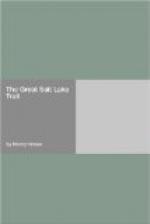It was fearfully cold, the thermometer ranging about twenty-five degrees below zero. Just as they started to put their plan in motion, another band of Indians was coming up the valley. These joined the others, and bore down on the white men.
On arriving at the base of the hill up which the white men were climbing, the Indians dismounted and started on foot after them. Seeing their tactics, Mr. Coad and his companions took off all their superfluous clothing and threw it away, notwithstanding the severity of the temperature. One of the men, in passing near a ledge of rock, discovered a hiding-place under it, dropped down and crawled in, filling his tracks with dirt as he backed into the cave. The Indians in trailing the party passed by this rock, returned to it, and held a council. They then went back to their horses. The other white men secreted themselves in a canyon, built a fire, and there remained until long after dark.
Left in the wagon-camp were three other men, who had a hard fight with the Indians from about eleven o’clock in the morning until three in the afternoon. They were inside of the cabin, and managed to keep the savages at a safe distance by firing at them through the crevices whenever they came within rifle-shot. The Indians kept riding in a circle around the cabin for several hours, and, finding they could not dislodge the three brave men, they abandoned the attempt, after losing one of their ponies, which received a rifle-bullet in his foreleg.
Some of the wood-choppers who had been at work a mile and a half up the valley also had an exciting experience during the day with the savages, but came out unharmed.
After the entire party of white men assembled in camp that night, a council was held, and it was determined to send a messenger to the commanding officer of the post at Julesburg, stating the condition of affairs and the number of Indians supposed to be in the vicinity.
The next morning Mr. Coad and his men gathered what cattle they could find, intending to leave for the fort. They started, got on top of the divide, and camped for the night. A raging blizzard set in, one of those terrible storms of snow and wind characteristic of the region, and the cattle sought shelter from the fearful weather by returning to the valley which they had left the day before, and where there was plenty of timber. The party was able, however, to hold a few head. So they hitched them up to the mess-wagon and returned to their old camp, intending to wait until the messenger they had sent to the fort should arrive with troops; but they were not sure he had gone safely through.
The next morning Mr. Coad started east on the divide on the only horse the Indians had left him, and about nine o’clock that night he met Lieutenant Arms, of the Second Cavalry, in command of Company E of that regiment.
Lieutenant Arms told him that he had met a large war-party of savages about four o’clock that afternoon, and was detained fighting them until after dark, when they disappeared and went south, at a point about ten miles west of Sidney. Lieutenant Arms had captured several head of cattle and two of Mr. Coad’s horses from the Indians in this engagement.




